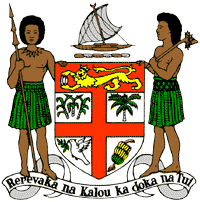|
About Fiji
Fiji lies in the heart of the Pacific Ocean midway between the Equator and the South Pole, and between longitudes 175 and 178 west and latitudes 15 and 22 south.
Fiji’s Exclusive Economic Zone contains approximately 330 islands, of which about one third are inhabited. It covers about 1.3 million square kilometres of the South Pacific Ocean.
Fiji’s total land area is 18,333 square kilometres. There are two major islands - Viti Levu is 10,429 square kilometres and Vanua Levu 5,556 square kilometres. Other main islands are Taveuni (470 sq km), Kadavu (411 sq km), Gau(140 sq km), and Koro (104 sq km).

|
National Flag
Fiji’s flag flew for the first time on Independence Day, October 10, 1970. It includes the red, white and blue Union Flag of Britain in the top left-hand corner and the shield from the Fiji Coat of Arms on a light blue background in the fly. The flag encompasses Fiji’s own colonial heritage in the Union Flag with a blend of historical continuity in the design of the shield. Fiji’s geographical design is highlighted by the blue background. |

|
Coat of Arms
Fiji’s national Coat of arms consists of the images of two Fijian warriors on either side of a shield and the motto "Rerevaka na Kalou ka Doka na Tul" below the shield. These words mean "Fear God and honour the Queen." The shield from the coat of arms has the image of a heraldic lion holding a cocoa pod across the top. Sugarcane, a coconut palm and bunch of bananas are represented in three of the sheilds sections. The fourth contains the reproduction of a dove of peace, the main feature of the Cakobau Government’s flag before cession. |
|


